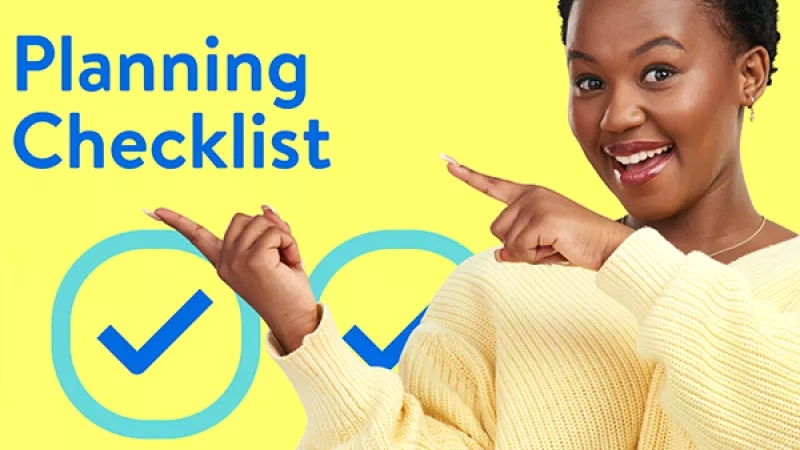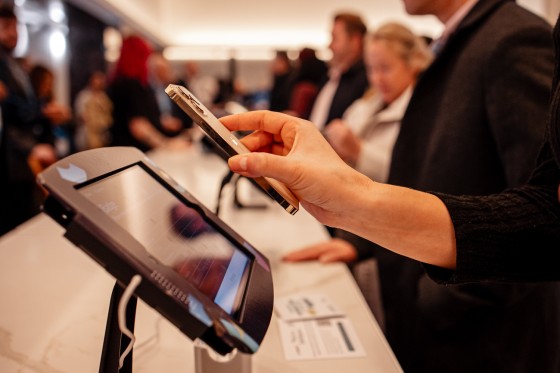In the dynamic world of event planning, conference planning stands out as a critical skill for event planners and marketers. Whether you’re orchestrating a small seminar or a large-scale industry convention, the success of your conference hinges on meticulous planning and execution.
A well-organized conference not only enhances your brand’s reputation but also delivers a memorable experience for attendees. But, where do you begin?
Let’s delve into the essential steps and strategies for conference planning that can ensure your event runs smoothly and achieves its objectives. From selecting the perfect venue to crafting engaging content and managing logistics, we’ll provide you with the insights needed to plan a successful conference.
How to plan a successful conference: 11 Steps
Planning a successful conference involves a series of well-coordinated steps, from conceptualization to execution. Whether you're planning a traditional in-person gathering, a virtual conference, or a hybrid event, meticulous attention to detail is required, and this step-by-step guide can help you navigate the complexities of conference event planning to ensure your event is well-organized and memorable.
Step 1: Define your conference goals and objectives
The foundation of any successful conference is a clear understanding of its purpose. Start by identifying your primary goals and objectives. Are you aiming to educate, network, or promote a product or service? Clear goals will guide every aspect of your planning process, from selecting conference themes to determining your target audience.
Step 2: Choose the right conference theme
The conference theme that you select will set the tone for the event. This theme should resonate as much as possible with your target audience and align with your conference objectives as well as your organization’s broader business and branding goals.
When considering the most sensible conference theme, it’s wise to keep in mind current trends within your industry and determine how to make your conference stand out. A well-chosen theme enhances the overall experience for attendees and makes your conference more marketable.
Step 3: Determine the best event format
Is your conference going to take place in an in-person, virtual, or hybrid format? It’s up to you to decide which format makes the most sense based on your conference goals, theme, target audience, etc.
For instance, 80% of attendees say in-person events are the most effective way to discover new products. That doesn’t mean hybrid and virtual events are less valuable; they simply serve different purposes.
Carefully consider what type of programming you want to offer during your conference, what types of attendees you want to reach, how far-flung your prospective attendees might be, and what your budget allows for.
Step 4: Develop a detailed conference agenda
A well-structured conference agenda is essential for attracting attendees and keeping them engaged during the event. Plan sessions, workshops, keynotes, and activities that align with your theme and objectives.
Consider incorporating a mix of interactive elements, such as panel discussions and Q&A sessions, to engage your audience. For virtual and hybrid conferences, ensure the agenda accommodates different time zones and is interactive enough to keep online attendees engaged.
Be sure to bake in planned breaks, mealtimes, networking opportunities, and entertainment so attendees can maintain their energy throughout the conference and remain engaged in your programming.
Step 5: Assemble a skilled conference management team
Effective event management requires a dedicated team with clearly defined roles. From logistics coordinators to marketing specialists, each team member should be well-versed in conference management practices.
Make use of conference management tools to streamline communication, keep track of tasks and progress, track registrations, and a wide range of other conference planning elements.
Step 6: Select your ideal venue or virtual platform
Whether you’re hosting an in-person event or a virtual conference, choosing the right venue or platform is critical.
For in-person events, you'll be searching not only for the perfect location but the ideal venue and accommodations, as well. You’ll need to be sure your venue offers the necessary space and amenities to accommodate your conference, so consider using a venue sourcing tool to search for options and help you compare pricing and features.
If you plan to host a virtual or hybrid conference, invest in a reliable platform that is user-friendly and supports live streaming, breakout rooms, and interactive features. Be sure the platform can accommodate your streaming needs as well as your expected number of attendees.
Step 7: Design your conference marketing strategy
Your conference's success depends largely on your ability to attract attendees. Promote your conference through a range of channels, including social media, email marketing campaigns, sponsorships and partnerships with industry influencers, etc.
Offering early-bird discounts and group rates can boost sales and provide useful insights into buying patterns as you prepare for the conference.
No matter your marketing strategy, create compelling content that highlights the benefits of attending your conference and what sets it apart from similar events, such as:
- Guest speakers
- Workshop leaders
- Novel interactive activities
- Unique networking opportunities
- Hired entertainment
- Industry awards
- Exclusive looks at new product releases
Don’t forget to talk up the fun swag, giveaways, raffles, and contests. Anything to excite prospective attendees can help drive registrations for those who are on the fence about the value of attending.
Step 8: Coordinate logistics for onsite, virtual, or hybrid event management
Effective event management ensures everything runs smoothly on the day of the conference. Whether your conference is in-person, virtual, or hybrid, smooth logistics are key to a seamless experience.
For in-person events, logistics are a hefty undertaking. You’ll need to keep track of transporting staff; shipping and setting up equipment, signage, and other materials; catering; local transportation schedules; accommodations for attendees, speakers, and other stakeholders; sponsor and exhibitor setups; and so much more.
For virtual conferences, things are simpler. Test your technology in advance, set up as much content and back-end features in advance as you can, provide clear instructions for accessing the platform, and have technical support on standby to address any issues.
Of course, hybrid events offer attendees the best of both worlds, which means you’ll need to manage both in-person and virtual logistics.
Step 9: Engage attendees with interactive elements
Incorporate interactive elements such as Q&A sessions, live polling, and networking activities to keep attendees engaged throughout your event. For virtual conferences, consider making use of virtual breakout rooms, live chats, polling, and surveys to encourage increased engagement.
Step 10: Gather feedback, evaluate ROI, and consider future changes
After the conference, gather feedback from attendees via post-event surveys to evaluate the event’s success. Collect data during the conference, and turn it into actionable insights to help your team understand what worked well and what you can improve for future events.
Don’t forget to send follow-up emails, leverage social media to share event highlights, and nurture the relationships and leads you built during the conference.
Your event stakeholders will want a breakdown of your wins and misses, so be prepared to share an event debrief as well as a plan to improve future events.
Step 11: Do it all with conference management software
Realistically, getting your event tech in order should be your first step, as your tech stack can help make every other step in this process simpler, more efficient, and even more cost-effective.
With the right conference management software by your side, you can streamline not only your planning process but the execution and evaluation of your event. These tools can help with venue sourcing, registration, scheduling, attendee management, tracking leads, collecting feedback, and even helping you make decisions about your event format and theme based on past event data.
Pre-game: Before the conference
The success of any conference hinges on thorough preparation well before the event kicks off. For event planners and event marketers, the pre-conference phase necessitates laying the groundwork that ensures everything runs smoothly on the big day. Here’s a breakdown of the essential tasks to complete before the conference—think of this as your conference organization checklist.
Establish clear goals and objectives
Before diving into logistics, it's important to define what you want to achieve with your conference. Whether it's boosting brand awareness, generating leads, or providing educational value, having clear goals will shape every aspect of your planning process.
Develop a comprehensive budget and event strategy
Budgeting is a critical task that must be tackled early in the planning process. Start by estimating costs for key elements such as the venue, speakers, marketing, technology, and catering. Make sure to allocate a portion of your budget for unexpected expenses. A well-planned budget helps avoid financial pitfalls and ensures that all aspects of the conference are covered.
Create a detailed project timeline
When considering how to plan a conference, you’ll want to create a conference planning timeline. This timeline acts as a detailed roadmap that covers all aspects of your conference. List all major tasks and milestones that need to be completed leading up to the event, including:
- Budget allocation
- Booking the venue
- Finalizing speakers
- Content creation
- Launching marketing campaigns
- Sending invitations
- Technology requirements
- Logistics planning
- Contingency plans
Secure key partnerships
Identify and lock in partnerships early. These include:
- Sponsors
- Vendors
- Speakers
- Exhibitors
Assign deadlines to each milestone and task, and monitor progress regularly to stay on track.
Design an engaging program
Craft a conference schedule that balances informative sessions, networking opportunities, and interactive elements. Consider incorporating:
- Keynote speeches
- Panel discussions
- Breakout sessions
- Workshops
- Networking opportunities
- Wellness breaks
- Social events
It’s important to ensure the program flows smoothly with enough time allocated for each activity as well as some down time.
Curate your speaker lineup
The quality of your speakers can significantly impact the success of your conference. High-profile speakers can draw larger crowds and enhance the status of your event. Start by identifying industry experts and thought leaders who align with your conference themes. Reach out to them well in advance, and be sure to provide clear expectations and requirements.
Implement a marketing plan
Marketing your conference is key to attracting attendees. Develop a multi-channel marketing strategy and use engaging visuals, compelling messaging, and targeted outreach to build buzz. Your conference marketing ideas should play off your theme and industry as much as possible to effectively draw in attendees.
Prepare event materials
From event badges to conference programming, everything on your conference materials checklist should be prepared well in advance. Ensure all branding is consistent and aligns with your conference themes, and make sure materials are easily accessible to attendees.
Ready your team
A well-prepared team is necessary for smooth event execution. Assemble and brief your event staff:
- Assign roles and responsibilities
- Conduct training sessions
- Create detailed event playbooks
- Schedule pre-event meetings and rehearsals
- Book travel and accommodations
Test your tech
Technology plays a pivotal role in the success of your conference, especially for virtual and hybrid events. Conduct thorough tests of all systems, including registration platforms, presentation equipment, and live streaming services. For in-person events, ensure audiovisual equipment, Wi-Fi, and other tech resources are in optimal working condition. Have backup plans in place in the event of unforeseen glitches.
Coordinate with vendors and suppliers
Choosing the right vendors is fundamental to an event’s success. Decide which types of vendors you’ll need, and create a list of preferred event suppliers that have been vetted for quality and reliability. This can include categories such as:
- Audio-visual (AV) services
- Catering
- Transportation
- Décor
- Entertainment
- Security
Logistical planning is essential for smooth vendor operations. This includes coordinating delivery schedules and set-up times, and ensuring all necessary equipment and materials are onsite and ready for use for the big day.
Confirm all details with your vendors well in advance. Establish clear communication channels to handle any last-minute changes or issues that may arise.
Consider accessibility needs
For in-person, virtual, and hybrid events, you’ll need to make sure all attendees are able to participate in your event to the fullest extent possible. That means ensuring you’ve accounted for accessibility needs, including:
- ADA-compliant entrances, exits, restrooms, etc. at your venue
- Clear signage in different languages to assist in navigating your venue
- Accessible transportation options to and from your event
- Audio/visual tools to assist with speech, hearing, and sight limitations
- Trained staff who can assist with any onsite needs
Game day: At the conference
On the day of the conference, all the meticulous planning comes to fruition. This is when all your expert planning and organization pays off! Now, your focus is on ensuring the event runs smoothly, attendees have a positive experience, and any unexpected challenges are managed swiftly and effectively.
Facilitate a seamless check-in and badging experience
From the moment attendees enter your event or log onto your virtual platform, they should have a seamless, stress-free experience. For in-person events, that means making sure your onsite check-in and badging experience is simple to navigate and doesn’t cause any bottlenecking.
Tech is your friend here. With the help of self-service check-in kiosks, attendees can quickly check themselves in and even print their badges on demand. That means no sorting through bins of printed badges or searching for each attendee’s name on an alphabetized list—it's all automated!
Ensure everyone has access to the conference agenda
These days, attendees expect conferences to include a mobile event app that grants them access to the conference agenda, helps them keep track of their sessions, set up meetings with other attendees, and so much more.
Need to make a last-minute change to the agenda? No problem. As soon as you make the change, it will show up in your attendees’ apps, and you can even send notifications to provide attendees with timely updates.
Coordinate with speakers and presenters
Confirm all your speakers and presenters are ready and have all the materials and equipment they need. Assign a session host or moderator to introduce speakers, manage Q&A sessions, keep the audience engaged, and make sure your sessions stay on track and on time.
Do your best to create smooth transitions between sessions, with enough time allotted to set up and disassemble equipment, if necessary, without causing delays. The goal is to provide a sense of seamless transition between activities for conference attendees.
Encourage networking and engagement
Conferences are as much about networking and relationship building as they are about learning. Create opportunities for attendees to connect, whether through designated networking sessions, interactive workshops, or intentional breaks.
Make use of conference management software to facilitate connections by enabling attendees to schedule one-on-one appointments or join discussion groups. For virtual conferences, leverage chat rooms, forums, and virtual lounges to encourage interaction.
Monitor and address attendee needs
Keeping attendees satisfied and engaged is a top priority. Assign staff to circulate throughout the venue, ready to assist attendees with any questions or issues that arise. You can also provide a hotline for onsite questions, an FAQ page in your event app, and station staff at strategic touchpoints to help attendees navigate.
For virtual attendees, provide live support to resolve tech issues or answer queries, and make sure you’re monitoring virtual sessions to make sure there are no issues with your streaming or engagement features.
Oversee catering and hospitality services
For in-person conferences, catering and hospitality services play a key role in attendee satisfaction. Make sure attendees feel they are taken care of and receiving good value for their investment.
Remember to account for allergies, dietary restrictions, and preferences when planning menus. Staff should be readily available to address any issues or replenish supplies as needed.
Monitor real-time feedback and adjust accordingly
Real-time feedback is invaluable for making on-the-spot improvements. Creating social media hashtags for your event can be a great strategy for monitoring how attendees are enjoying their experience.
Surveys and other forms of direct attendee feedback can also help you gauge the success of each session and overall conference sentiments. If issues are identified, act quickly to resolve them. These can be simple changes like adjusting room temperature or more elaborate, such as fixing an issue with your closed captioning session displays.
Prepare for the unexpected
No matter how well-planned a conference is, unexpected challenges will arise. Be prepared with contingency plans for common issues, such as speaker cancellations, tech issues, power outages, personnel issues, or attendee emergencies. Having a crisis management plan in place can give you peace of mind knowing you will be able to respond in a calm and methodical manner to unforeseen situations.
Post-game: Conference assessments
It’s time to determine what worked well and what did not. Hopefully, you have collected feedback through multiple channels and can now dissect the raw data. Look at the post-game as a learning opportunity to help you achieve greater success at your next event.
Take time to analyze key metrics, including:
- Registration numbers
- Attendance rates
- Session participation
- Appointments booked
- Social media engagement
- Survey feedback
- Total revenue
- Sponsor revenue and broader ROI
- Leads generate
For virtual conferences, review metrics such as:
- Registration numbers
- Live stream attendance for each session
- Chat activity
- Polling and Q&A activity
- On-demand content download rates
- Social media engagement
- Survey feedback
- Total revenue
- Sponsor revenue and broader ROI
- Leads generated
Compare figures to determine how well they align with your pre-conference predictions and goals. Using predetermined KPIs and working through all the data available allows you to determine whether you have met your objectives.
Other areas to consider include:
- Evaluations of speakers: Analyze session attendance rates, length of time attendees stayed at a session, and post-session feedback to understand how well-received each speaker was.
- Session interest: Just as you evaluate your speakers, consider how well your session topics and content were received by analyzing the same types of attendance and feedback data.
- Logistical performance: Were there operational issues? Was your online platform reliable? Did your strategies to avoid and address tech issues work? Did your venue come with any unforeseen headaches, or did things run smoothly?
- Marketing and promotion success: Analyze metrics such as organic website traffic, app usage, email open rates, social media reach, and conversion rates for paid ads. Note which marketing channels paid the best dividends when it comes to driving attendance and engagement. Also review the success of sponsors’ and other partners’ campaigns to see how much their marketing impacted the success of your event.
Conduct a financial review
In short, did you achieve your desired return on investment (ROI) and stay within budget? Compare your actual expenses against your budget, noting any areas where costs exceeded expectations or instances where you ended up saving resources.
Review revenue streams, such as ticket sales, sponsorships, and vendor fees, to determine overall profitability.
Debrief with your team
Hold a post-conference debriefing session with your event management team. Encourage open discussion about what went well and what challenges were encountered. Document these insights for future reference, and use them to improve future event game plans.
Make sure to recognize the hard work of your team and discuss any areas where additional training or resources may be beneficial.
Thank speakers, sponsors, and attendees
Expressing gratitude to those who contributed to the success of your conference is an important step in the post-game phase. Try your best to personalize these interactions, highlight valued contributions, and follow up on discussion items that might have come up during the event.
For attendees, a well-crafted “thank you” email can go a long way in maintaining positive relationships, encouraging future participation, and ensuring attendees continue interacting with your brand beyond the life of your event.
Consider sharing event highlights, key takeaways, and any links to the event recordings (if applicable) as part of your follow-up communications.
Create a post-event report
Summarize your conference assessment findings in a comprehensive post-event report. This report should include attendee feedback, key performance indicators (KPIs), financial analysis, and notable takeaways from your debriefing session.
The report serves as a valuable reference for future events and can be shared with stakeholders to demonstrate the conference's impact and areas for improvement.
Conference planning checklist
Ready to pull it all together? Use this conference planning checklist to help you through every stage of planning, executing, and evaluating your conferences.
- Set objectives and goals
- Determine your budget
- Select your event venue and date(s)
- Develop your event timeline
- Create a team and determine roles and responsibilities
- Plan your conference programming
- Choose and book speakers
- Set up a registration site and ticketing system
- Implement an event marketing plan
- Arrange catering
- Determine logistics and acquire necessary equipment
- Coordinate with vendors and suppliers
- Arrange accommodations and transportation
- Train event staff
- Conduct final equipment checks
- Manage on-site registration and check-in
- Oversee event execution
- Monitor and address attendee needs
- Collect feedback to evaluate your event’s success
- Report on your conference ROI and plan for next time!
Frequently asked questions
How do you make a plan for a conference?
Whether the goal of your conference is to educate, network, promote a product, facilitate industry discussions, or otherwise, having a clear set of objectives will guide all subsequent decisions, including selecting the right conference theme, identifying the target audience, and determining the overall structure of the event.
By establishing these goals early on, you'll have a solid foundation that shapes the entire planning process, ensuring that every aspect of the conference aligns with your intended outcomes. From there, you’ll want to use a conference planning checklist to make sure you have a comprehensive plan in place.
What’s the first step in planning a conference?
The first step in planning a conference is to define clear goals and objectives. Having clear goals and KPIs established will help you make strategic decisions throughout the rest of the planning process.
What are the main responsibilities of a conference and meeting planner?
A conference and meeting planner has a wide range of responsibilities to ensure events are successful, including financial management and budgeting, venue and vendor selection, program development, marketing and promotion, attendee management, onsite event management, and post-event analysis.
These responsibilities require strong organizational, communication, and problem-solving skills, as well as the ability to manage multiple tasks and details simultaneously.











